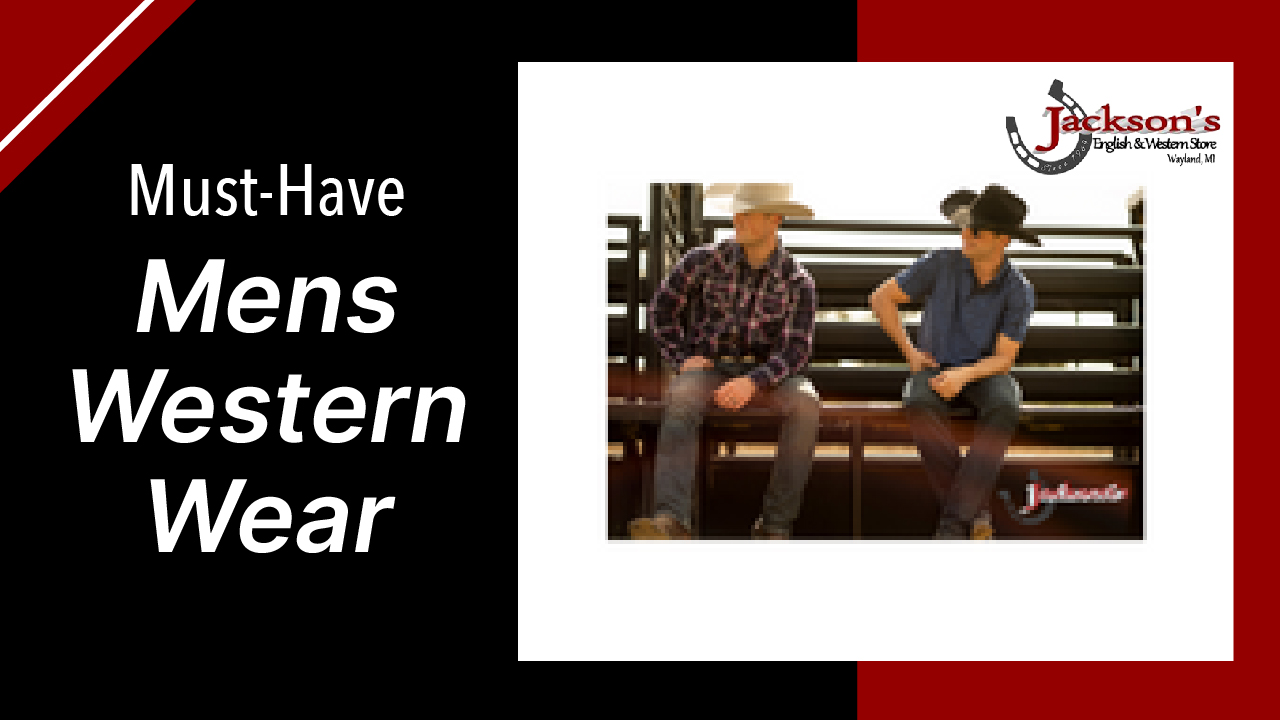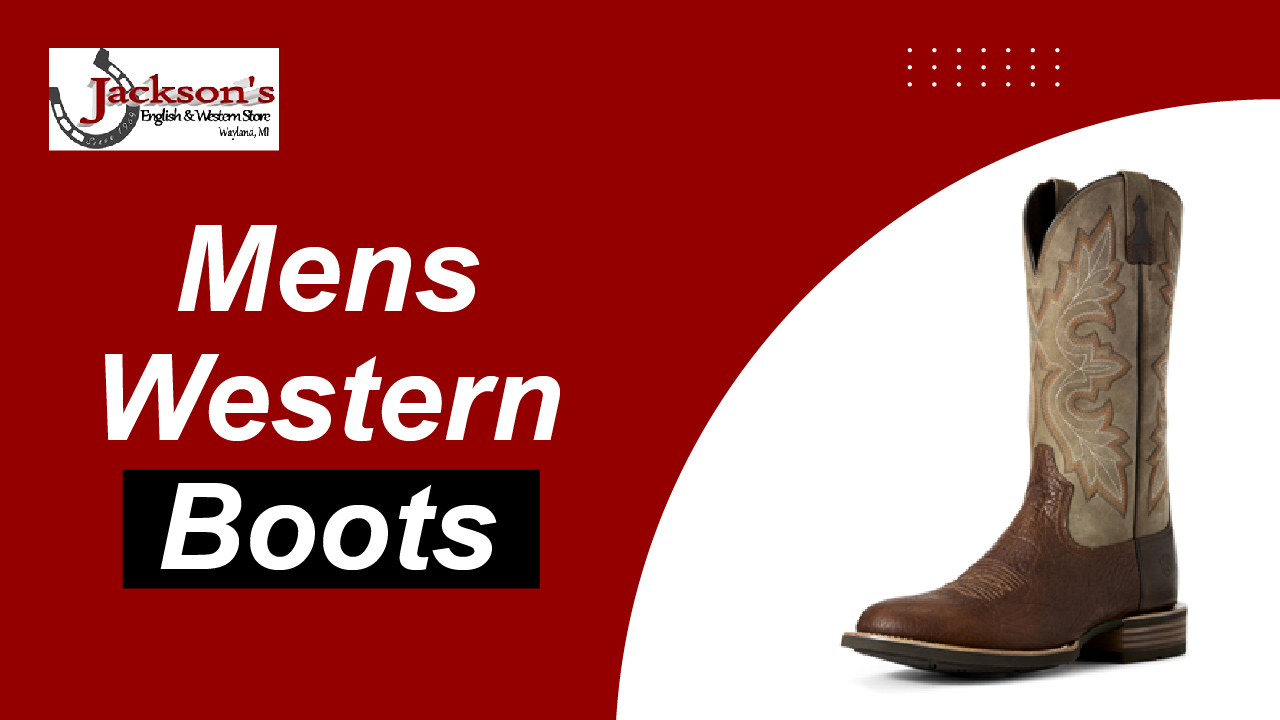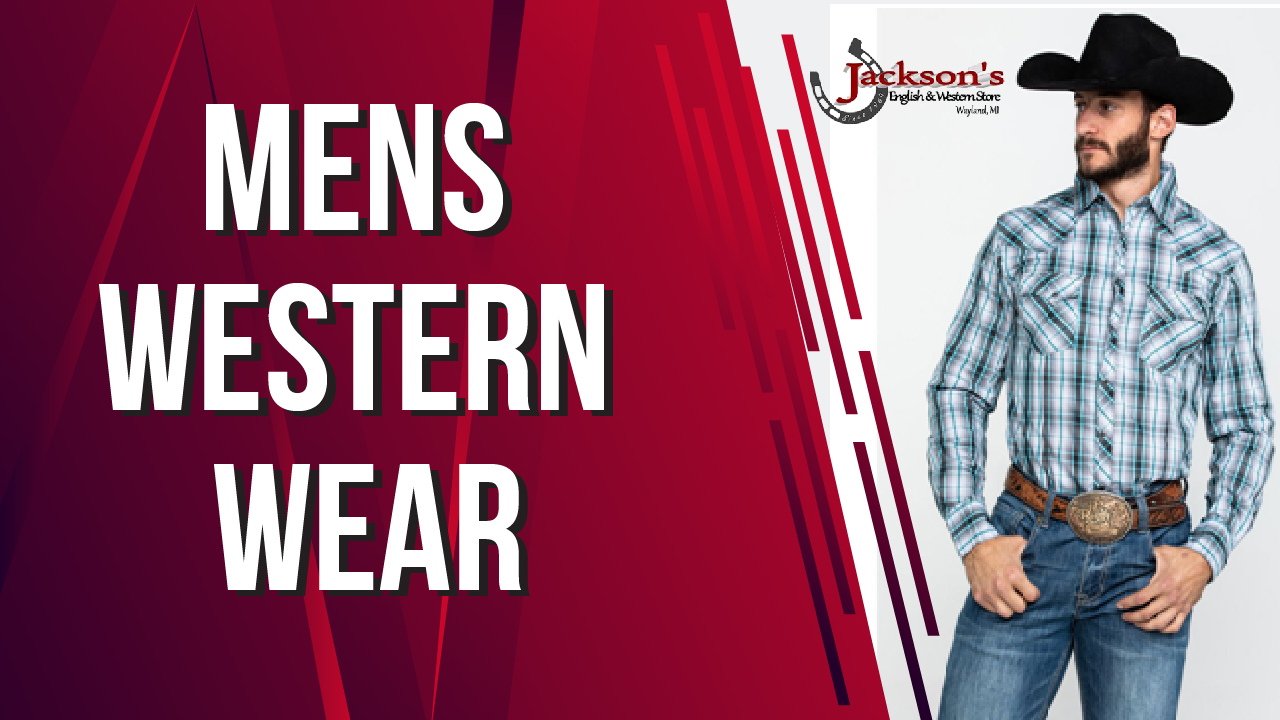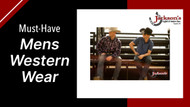Must-Have Mens Western Wear
Posted by Jackson's Western Store on May 26, 2020

The unyielding influence of the overhead sun; the unforgiving influence of the harsh, dry winds over the grasslands that stretch beyond sight; bitter winter rains and snows that bite and torch the skin; unbroken, wild spirited livestock that test mettle and grit. These are only a few of the things that stood in the way of the lives of the original pioneers and other men and women of the old west. The unforgiving landscape was difficult to husband, and the weather vacillated between wild extremes throughout the seasons. To survive, the people of the old west had to fight to raise livestock, grow crops, and much more - and to survive they needed clothes and other equipment that would protect them from the hazards of such lifestyle.
These are the things that colored the original catalog of mens western wear. It was necessity, not fancy, that drove men to take up protective hats, supportive boots, and capacious, flexible shirts, although over time decoration made inroads into the design, and western wear became a fashion statement as well.
Today, the popular image of the cowboy or ranch hand reflects this western wear, and to those who still live the lifestyle, western wear is just as much about function as it ever was. That being said, you might even be one who would call the addition of a pair of western or cowboy boots to some blue jeans and a simple button-down shirt “western wear.” You wouldn’t necessarily be wrong, but at the same time, there are certain fixtures of men's western wear that are incontrovertible. There is a collection of gear that, when put together, makes up the iconic image of a western man. Moreover, if you take part in showmanship, riding, and other competition, there are aspects of the dress that are taken into account when scoring.
Even so, western wear for men today can be a fashion statement or a matter of course. It’s one of those rare schools of fashion where function was the origin and remains the hallmark. Start here with this must-have men's western wear for putting together a western ensemble and you will be just as ready to cut a caper as you will be to work in the fields.
Men’s Western Hats
The cowboy hat or the men’s western hat might be the contender for the most immediately recognizable feature of a western man. That honor might go to the boots, but we haven’t gotten there yet.
A cowboy’s hat is a staple of western wear, and without one, you could hardly be said to be arrayed in men's western wear in the first place. That being said, and as immediately recognizable as they are, they were not designed to catch the eye, but rather to protect them - and the rest of the cowboy.
Pioneers and other settlers who dared to fare the plains of the west were met with the harsh conditions described at the outset of this article and then some. They faced a hot, bright sun and at other times of the year, driving sun and rain. They also crossed very dry expanses of prairie that stretched for miles. They needed a solution that would make their lives easier.
That’s where a visionary by the name of John. B Stetson entered the mix. In 1865, he released a hat that became known as the iconic “Boss of the Plains.” Made of felted wool, with a round crown and a flat brim, it was custom made for life in the west. In one fell swoop, it transformed the lives of pioneers and the nature of a ‘cowboy hat’ was forever after altered.
Its wide brim shielded the wearer’s eyes from the beating sun and could help to cut down on glare as well - both of which could be serious problems on the plains. As it was made of felted wool it offered fair insulation and thermoregulation throughout the seasons.
Perhaps most importantly, as felted wool can be made entirely waterproof, it helped to protect the wearer against driving rain and snow, but the benefits don’t end there. Its round crown increased the capacity within the hat and could be used as a vessel from which to water a horse. Moreover, the wearer could use the brim as a funnel to direct water to his own mouth. It was a tool that entirely changed the lives of people in the west.
Today you can still find protective, waterproof examples of cowboy hats. Many are still made of felted wool or fur, but you can also find models here at Jackson’s English & Western Store in leather and even straw. We offer many fine examples from Stetson, Resistol, Bailey and more. They are an essential component of men's western wear - so if you are interested in a western outfit, you certainly need at least one.
Western Boots

If the cowboy’s hat isn’t the definitive piece of western wear, then that laurel probably goes to his boots. A cowboy’s boots are certainly one of the most indicative features of men's western wear. Much like everything else associated with western wear, cowboy boots have an idyllic look that came about due to necessity rather than by fashion preference. Western boots are known by their lace less leather construction and tall leather shafts that typically feature ornate traditional stitching patterns.
Western boots typically have a pointed or a round toe because, after all, they are designed for cowboys and needed to facilitate inserting a foot into a stirrup. (Some models have a square toe that would have been more uncommon, historically.) They also have a high, sharp heel that helps the rider get a better grip on the stirrup while riding.
They are lace less because laces only serve to catch on tack or other obstacles while riding and can increase the chance of injury. As for the high shaft, much as chaps protect the thighs while riding, the shaft of a cowboy boot would protect the rider against briars, stones, bark, and even things like wire and snakebites.
As you can see, the design of western boots came about through the refinement of functional considerations and not through fancy. That being the case, today’s cowboy boots can be real pieces of art, and they offer much more protection due to technological advances than the boots of yore.
They’re an essential part of any western ensemble, and here at Jackson’s English & Western Store, you can find cowboy boots and other work boots from Ariat, Dan Post, Twisted X, Double H, Justin and many more. Just like with historical boots, our boots are selected from among the best brands and represent the highest quality in western boots.
Best of all, if you are ever able to visit us in our store in Wayland, Michigan, you can take advantage of our boot fitting, stretching, and break in services that are complimentary with purchase. Fitting boots properly is essential to getting a pair of boots that you can use, and breaking them in can be an arduous and painful process. It doesn’t need to be, though, and our team has many years of experience fitting and stretching boots. It’s something you can experience first hand if you ever get around to visiting our Michigan store.
Belts and Belt Buckles
Depending on your need for western wear, a belt with a prominent buckle might be a requirement for your sport or your competition. Belts and buckles do serve the necessary function of holding up and securing pants, and they also serve the function of securing sheaths and holsters for tools and firearms. Therefore, like everything else on this list, they are rooted in function, yet at the same time allow you a great amount of room for artistic expression.
Here at Jackson’s Western, you can find belts and belt buckles to suit just about any fancy, from plain full-grain leather belts to highfalutin polished gold and silver-tone belt buckles to draw the inspiration of a crowd. Many of our buckles feature attractive western motifs such as horses, cattle, and wildlife, and each of them is worth a view. Take a look through our pages of belt buckles to find the perfect fit for your style.
Neckwear
It is also customary for a men’s western outfit to contain some form of neckwear, usually in the form of a neckerchief or a bolo tie. Both of these, as with everything else on their list, had their origins in function, but over time became adapted to use as an artistic medium for expression.
A neckerchief was used to protect the neck and the lower face from the dirt and grit of the trail, and it could also protect the skin from the sun, similarly to how a gaiter does today. A bolo tie takes the form of a length of cordage typically accented by some ornamentation. Today it is chiefly ornamental but originally it could have served to provide an emergency supply of cordage. Its origins are, however, slightly murky.
What isn’t murky is the fact that both of these examples of neckwear have become absorbed into the modern catalog of men's western wear, and you can find shining examples of western neckwear here on our site as well as in our store.
Shirts and Vests
Now we can get into some of the core substance of mens western dress. Naturally, you’ll need more than a hat and boots to complete the image of a western man, as critical as they are. Men’s western shirts are typically made of cotton because it can be made into a dense weave (like denim) that is protective and breathable. They are usually long-sleeved and have prominent buttons down the front and are typically collared and can be ornately decorated.
One style of men’s westerns shirt, the rodeo shirt, is characterized by having long tails that will not come untucked while riding, as well as plenty of room in the sleeves and body for allowing the cowboy to move around while working with livestock.
Sometimes western shirts like these are accented with a vest that offers the cowboy room to store tools and other effects while also offering the torso an additional degree of protection.
Over time, men’s western shirts and vests have become palettes for ornamentation, and many feature ornate decoration, often with stitching. Here on our website, you can find men’s western shirts from Cinch, Wrangler, Kimes Ranch, and many more.

Jeans, Trousers, and Chaps
Finally, we can get into the base of the outfit - the pants that round it all together. As much as any other item on this list, the origin of men’s western pants is in support and protection.
Perhaps the oldest men’s western pants were wool trousers that were tough and could keep the cowboy warm in cold weather and still relatively cool in the heat. Over time, cotton jeans became more prevalent because it was breathable and materials like denim offered excellent protection against the rigors of work in the fields. A pair of jeans is just as iconic a piece of western wear as a cowboy hat or boots, in a lot of ways.
Some riders wear chaps over their pants to protect their legs from the rough territory through which they ride, although over time, chaps have become more decorative than they used to be. It is not uncommon to find chaps today that are fringed and ornately decorated. The same could be said for many other examples of men’s western pants, which you can find here on our site from favorite brands like Wrangler, Ariat, and Rock & Roll Cowboy among others.
This isn’t the be-all and end-all of guides to men's western wear and cowboy clothes, but it is definitely a good place to start. A good pair of jeans with a bright belt and buckle, a western shirt with a bolo tie, a quality hat, and pair of boots set you well on your wear to the ideal western image. Start with that and you can really refine your sense of style from then on out. Take a look through our comprehensive collections of men's western wear and accessories to put together your outfit today, and if you have any questions on our products, give us a call at 269-792-2550. If you can visit us in-store, that would be even better, and you can take advantage of our expert services as well.

